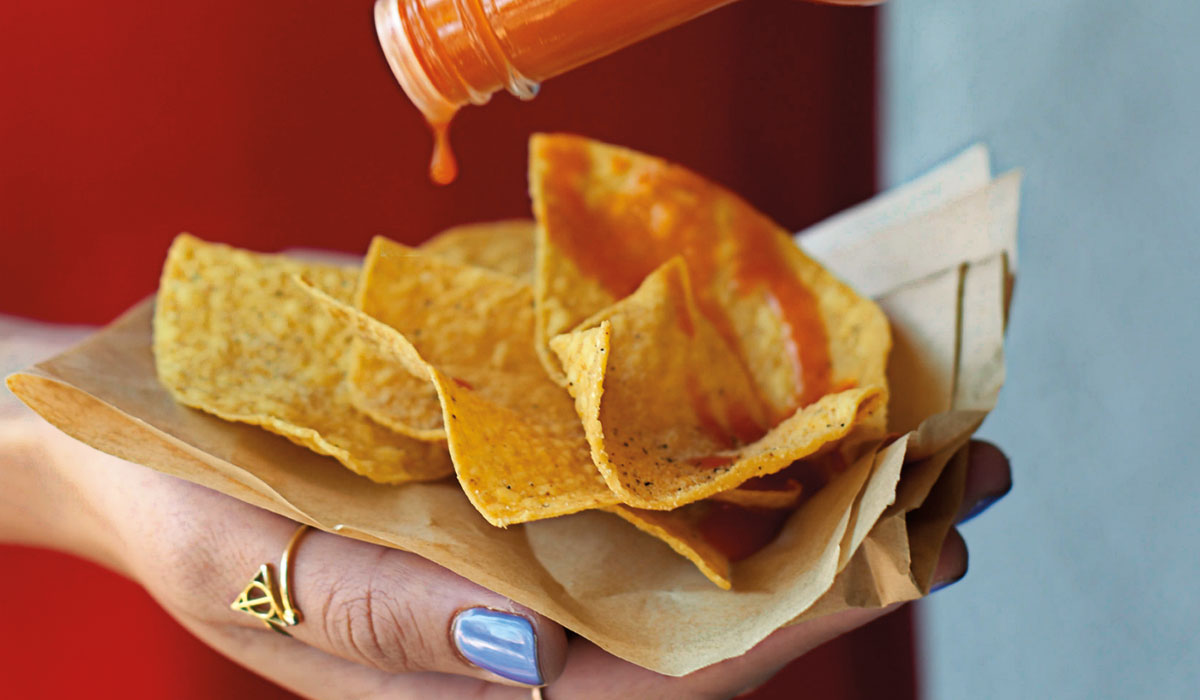It’s hard to imagine a quick-serve restaurant without some sort of sauce or condiment; just imagine a burger joint without ketchup. Condiments are such an integral part of most cuisines that entire restaurant concepts have been built around them.
Take Tijuana Flats for example, with its “Hot Bar” of hot-sauce selections that can pair with its Tex-Mex fast-casual menu. Or chicken concept PDQ and its nine available dipping sauces. Then there are the more ordinary examples; from the prevailing white ketchup cups to a glove box full of Taco Bell hot-sauce packets to the careful tapping of a Heinz 57 bottle, condiments are as much a part of the eating experience and culture of quick service as the proteins, the sides, or the convenience.
But to say that condiments are limited to ketchup and mustard these days would be far from the truth. With global concepts growing in popularity, condiments can be anything from tzatziki to sriracha to chutney, or mashups like gochujang ketchup or spicy honey. A restaurant like Curry Up Now differentiates itself with tamarind chutney, but also takes a chance on more standard sauces; for example, it serves an Indian-style ketchup called Maggi Hot and Sweet.
Founder and CEO Akash Kapoor says we have sriracha to thank for the broader experimentation from limited-service brands like his. “Sriracha has paved the way for a spicier and bolder palate, and we’ve seen that impact at Curry Up Now through our guests asking for much more in condiments and sauces,” he says.
Of course, not every brand can get away with tamarind chutney. Those concepts occupying more standard quick-serve categories are exploring condiment innovation as well, but while recognizing certain customer expectations.
“At the end of the day, we want our food to be memorable and craveable, and if that falls into the trending world, then that’s a bonus,” says PDQ’s executive chef, Michael Brannock. PDQ offers a Thai peanut sauce and has used ingredients in its condiments like Aleppo pepper, horseradish, and anchovy.
The same goes for Dog Haus, the Pasadena, California–based fast casual that serves upscale hot dogs, sausages, and burgers. “We are always blending the line between recognizable/nostalgic and new/innovative,” says cofounder Hagop Giragossian. From its spicy basil aioli to its miso ranch, Dog Haus’ goal is to balance salty, sweet, spicy, and fatty in each menu item, he says, using condiments and other ingredients.
For a burger chain with more than 800 locations, Whataburger works actively in the condiment innovation space. The company has developed its own condiments like ketchup, spicy ketchup, mustard, honey barbecue, and jalapeno ranch, and even bottles and sells them. Vice president of retail Mike Sobel says customers are looking for new, unique flavors.
Brand spotlight /
“We try to create burgers that our customers really crave,” he says. “A big part of that is sauces, which have to be complementary and have staying power, but not be afraid of bold flavors.” Whataburger offers customization but has spent a lot of time and effort researching and experimenting with sauce formulas and pairings, Sobel adds.
Many brands concentrate on a particular core condiment that they can then build on and create a specialized brand identity. McAlister’s features a honey mustard sauce as one of its big movers. The honey mustard has a built-in sweet, hot, and savory flavor profile, but McAlister’s builds on that within the menu. For example, it adds black cherry purée to make a spread for a ham and cheese sandwich.
“What the guest is craving is something unique in flavor to add to an ordinary, everyday dish,” says William Eudy, McAlister’s corporate executive chef.
Some brands add condiments straight to a dish. Some let the customers decide what gets added. And others do a little bit of both. Leaders at Curry Up Now enjoy watching their guests create flavor combinations through sauces and condiments that they otherwise would never have thought of. “We’ve discovered our customers typically want three to five choices,” Kapoor says of consumer condiment demands.
Dog Haus has fun with experimentation and builds on familiar flavors with a twist, like adding gochujang to a dressing and keeping the name Thousand Island, Giragossian says. “I would rather create a trend than follow one,” he says, citing his recent interest in fermented things, as well as wasabi oil.
Operators search for the next condiment trend in many places. Eudy at McAlister’s is looking to the eastern Mediterranean, Chile, and North Africa for the next big thing. Kapoor at Curry Up Now has noticed Middle Eastern schug taking off, as well as the 120-plus chutneys and sauces of India.
Honey usage has increased 11 percent on restaurant menus in the past six years, according to the National Honey Board, with an average of 4.4 honey items per menu in the fast-casual sector and an appearance on more menus than mayonnaise or mustard; that especially goes for the trending spicy honeys. And yet ketchup is the No. 1 preferred condiment by quick-service consumers, according to Golden State Foods, which manufactures 16.8 billion ketchup packets per year.
So it’s back to the start. It’s impossible to do burgers and fries without ketchup, but today’s demanding quick-serve market also requires a little pizazz with that ketchup—perhaps some honey or gochujang, or a mashup with mustard or sriracha.











